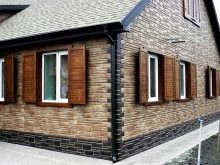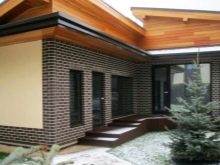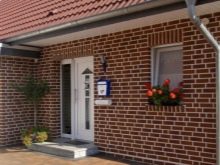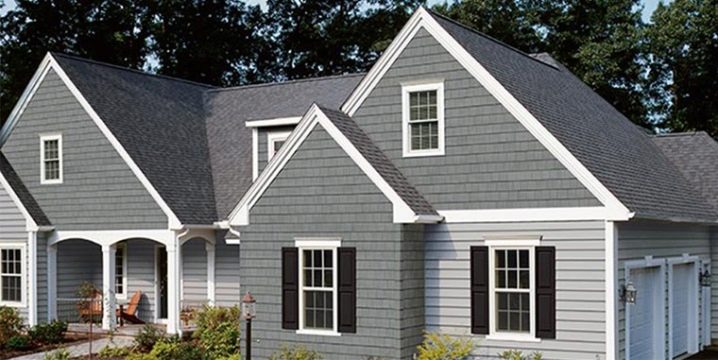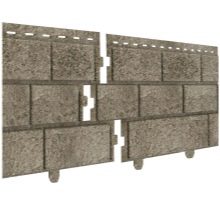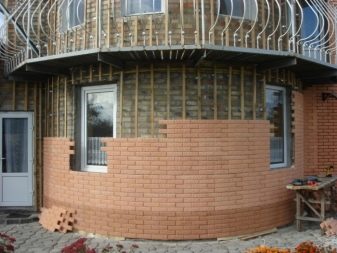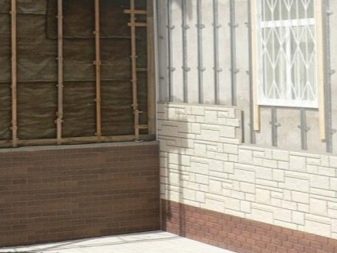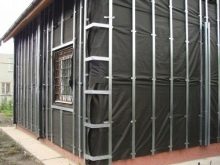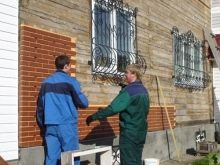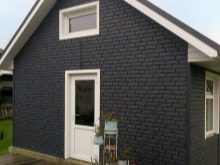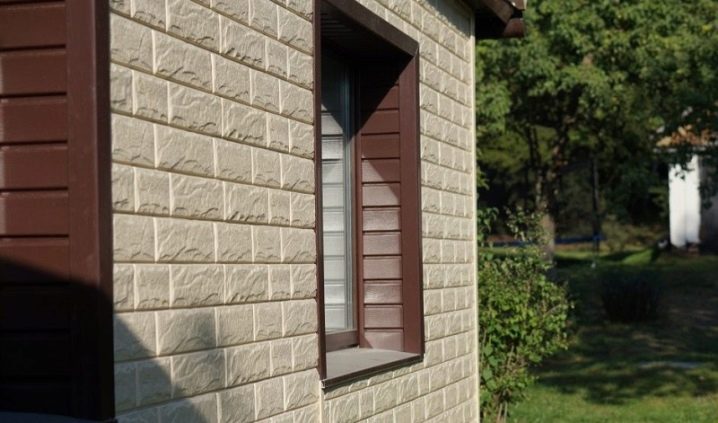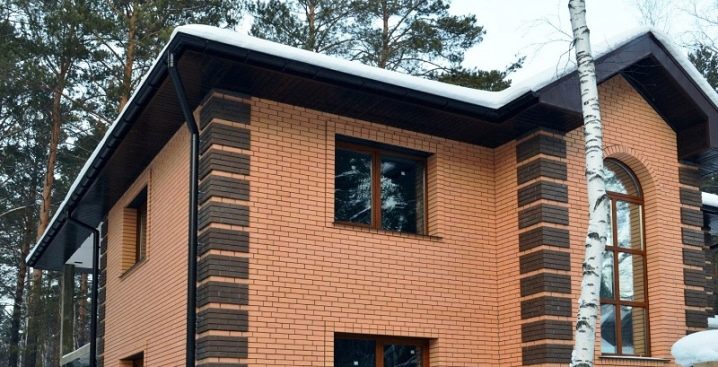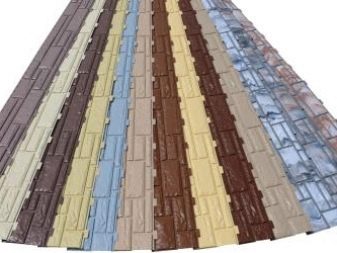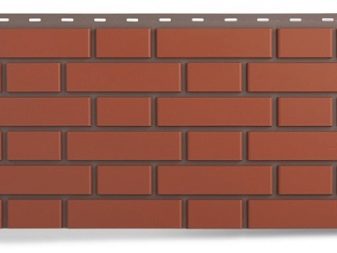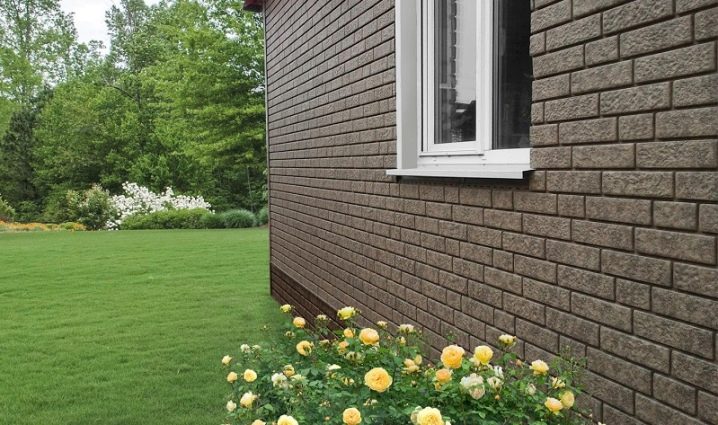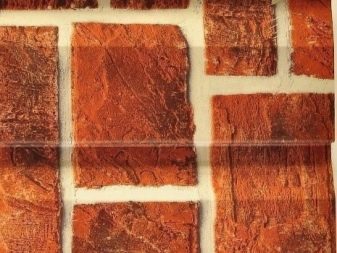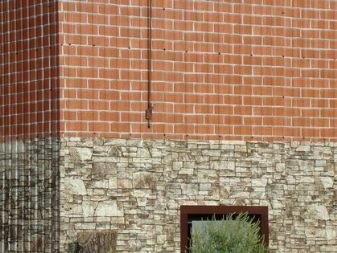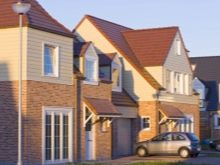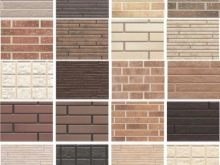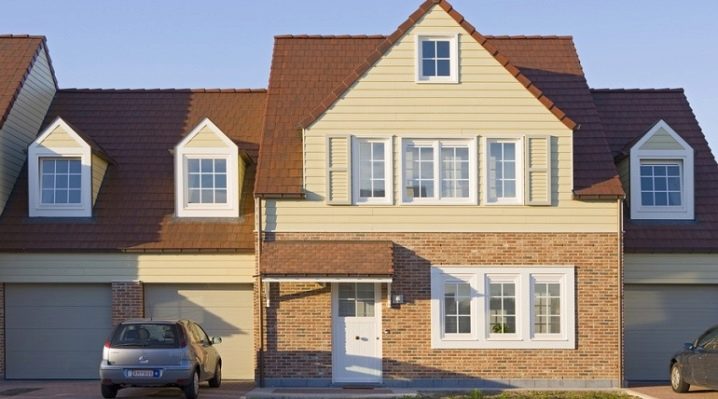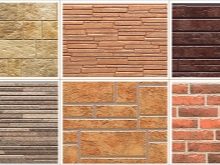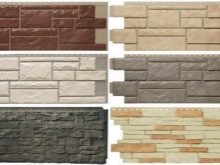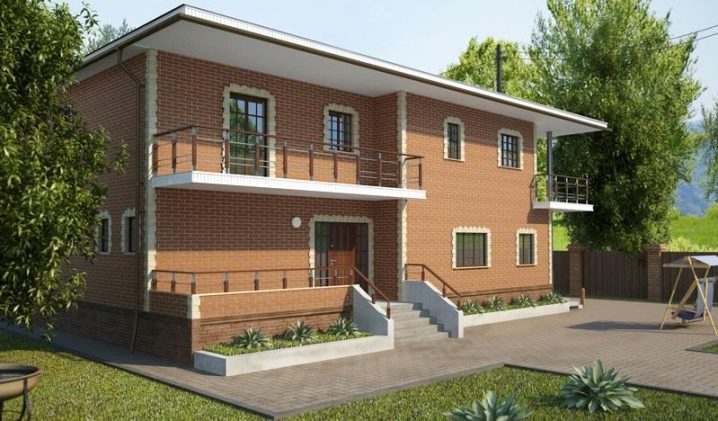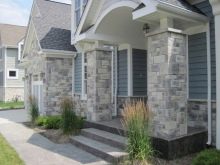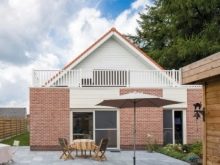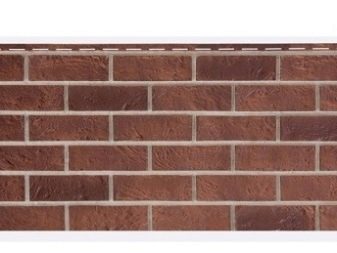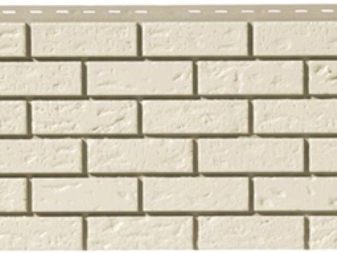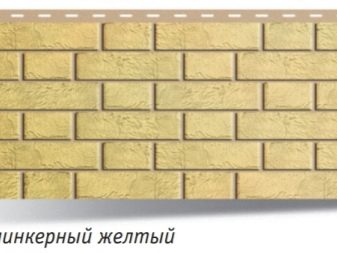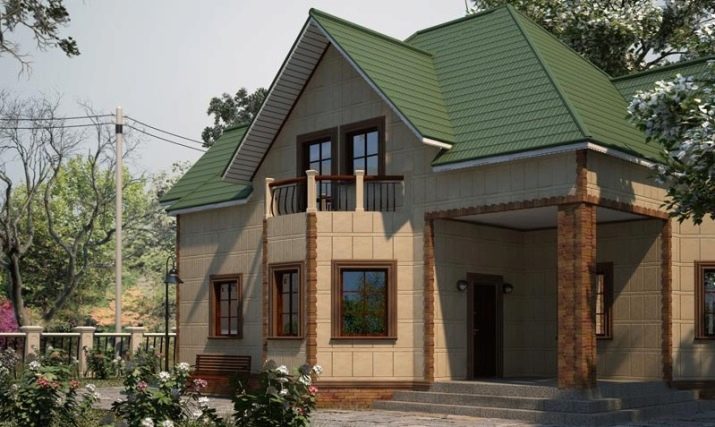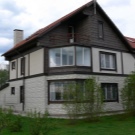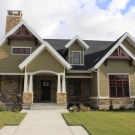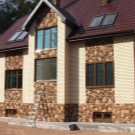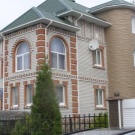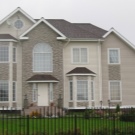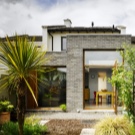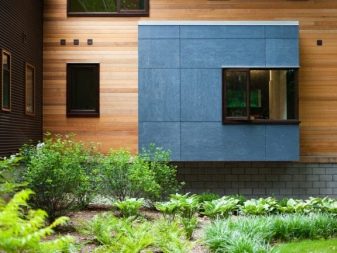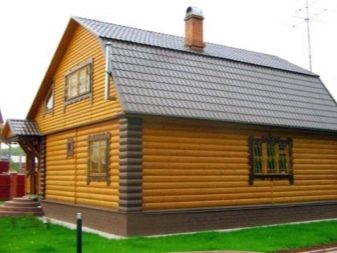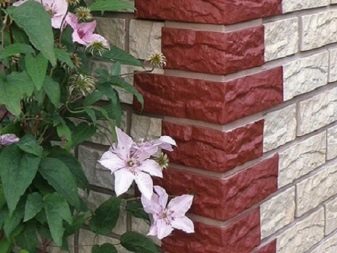Brick siding: the pros and cons
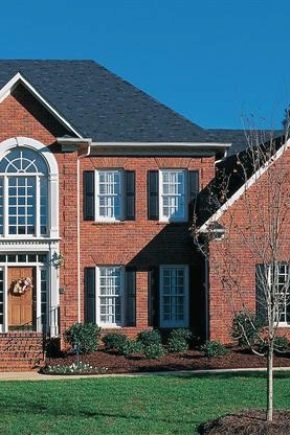
Brick houses are invariably considered a symbol of reliability and prosperity for a century and a half, which is why the percentage of country residences made of this material is so large. However, the construction of such housing requires serious financial investments and time consuming. For those who want to decorate their home with such a clutch and do not stay at a loss, manufacturers offer siding as a brick.
Special features
Siding, firmly rooted in the construction dictionary, is for the most part the process of covering the facade of a building. Another meaning of the term is a fairly new material (20 years ago they did not know anything about it in our country), which sheathed buildings.Appearing in the 50s of the twentieth century in America and Canada, siding has recently appeared on domestic spaces. It is vinyl, metal and wood.
An important fact is that not only new buildings are trimmed with siding, but also old buildings are being restored. The panels not only give an aesthetic appearance, but also protect the main walls from destruction.
Directly brick siding is made of vinyl, metal, and basement. Vinyl is made from lower cost PVC. The most popular is the basement, which is made of polypropylene, has high strength and is so natural that it is almost indistinguishable from brick.
Brick siding has its pros and cons, like any building material.
Among the advantages are the following:
- Siding can be covered with any surface of the walls - from the foam block to the bar, it is only important that the shrinkage of the walls be completed, and all defects cleaned and fixed.
- For mounting on the walls, a special supporting grille is fixed, on which decorative panels will be laid. As a result, there is a small gap between the main wall and the decorative coating that performs ventilation functions.Thus, brickwork will serve as additional protection from external environmental influences and will not create a greenhouse effect.
- Under the skin you can put any layer of insulation, while the appearance does not suffer: with proper installation, you can understand that the house is not bricked up, you can only come close to the walls.
- Durability. Provided that you have bought a high-class finish, the siding will last for about 50 years - the same amount of red brick will stand without finishing. However, to ascertain this is still problematic, since siding on domestic open spaces has been performed for less than 30 years.
- UV resistance - the panels do not fade in the sun and remain bright for many years.
- Durability - damage to the structure is possible only with strong mechanical action.
- Ease of installation - the panels are joined according to the principle of the designer.
- Practicality is characterized by a minimum amount of waste when facing the facade.
- You can easily replace the damaged panel.
- Environmental friendliness.
- Does not require much labor.
When choosing a brick siding, consider the disadvantages of this finish:
- Finishing the house with combustible material is quite a risky enterprise.
- The difference between real and artificial laying is distinguishable, albeit from a short distance.
- Limited color range.
- Installation under the force to produce professionals with special equipment and skills: it is important to strictly adhere to the technology of cladding and work safety.
- The large overall weight of the panels requires the creation of an additional framework, the strengthening of the foundation, which affects the finances.
- The price for plinth siding is quite high compared to plastic panels.
Despite the rather serious disadvantages, it is still cheaper to produce siding under a brick than to drive a whole house out of stone. In addition, the care of the panels is quite simple - it is enough to wash the accumulated dust with water, and many manufacturers have taken care of additional protection against burning and smoldering with fire-resistant compounds and substrates.
Kinds
Manufacturers offer a fairly wide range of colors for siding brick. Choosing decorative siding panels, you need to pay attention to the materials from which they are made.
Plastic siding is most popular with buyers. On sale it is represented by vinyl and plinth products. Vinyl is made from polyvinyl chloride (PVC), the basement is cast from more expensive polypropylene. Both materials accurately reproduce the structure of bricks, all pores and cracks.
The difference between the two types of plastic is in the thickness of the plate: the basement is more dense, it withstands scratches better, and the vinyl is thinner and lighter, but at the same time it has a more resistant color.
Vinyl siding is mainly used for facade finishing.Its bright colors remain so after ten years of operation. PVC panels have the structure of cells, so they retain heat well. Recently, insulated plastic sandwich panels with increased thickness appeared on the market. They do not require additional finishing insulation.
Polypropylene panels received the name thanks to the fact that are used mainly for finishing of a socle. Durable and flexible polypropylene can withstand severe mechanical stress. The color scheme of the socle panels is quite diverse: dark shades of burnt brick, clinker smoothness, golden and ocher are imitated equally well.Another important detail is the location of the metal batten when installing the basement siding under the brick. In harsh climatic conditions, it is raised by 10 cm from the ground, which freezes in winter. And if the climate is mild, then you can position the frame close to the soil.
Perhaps plastic siding does not look as natural as bitumen facade material with its natural basalt coating, but all the technical characteristics are in no way inferior, and the pricing policy is more democratic. PVC panels are equally well used for plating timber, block or brick structure.
Metal cladding material is made of aluminum, galvanized thin steel. The most popular is aluminum siding due to its price and ease of painting. At the same time aluminum is subject to deformation and it is unrealistic to return the original appearance of the panel. Also, the metal is susceptible to corrosion at the junction, and galvanized material tends to peel off the polymer layer. The richness of colors iron siding also can not boast.
This type of finish has its significant advantages:
- strength;
- durability;
- resistance to temperature shocks;
- not subject to rotting and mold propagation;
- does not fade in the sun;
- not afraid of moisture;
- installation can be made in any weather conditions;
- small weight of panels.
Fiber cement brick siding refers to the premium class of facade materials.
A mixture of cement with sand and reinforcing fibers creates a durable decorative coating, with indisputable advantages:
- durability;
- the safest material among brick siding;
- fire resistance - the level of flammability G0 and G1 - if the panels are coated with paint on the front side;
- moisture resistance;
- frost resistance;
- high bending strength;
- does not corrode;
- not afraid of external influences - temperature changes, UV radiation;
- does not fade in the sun;
- installation can be made at any time of the year and in all weather conditions - unlike, for example, from clinker bricks;
- Fiber cement panels house looks exceptionally respectable.
The existing range of brick siding is able to satisfy almost any demands of consumers in any climatic conditions.
Design
Front siding with brick imitation has long been a classic, suitable for any architectural forms and solutions. A real brick is in fact only red and yellow, and modern production technology allows us to significantly expand the color range of panels for brick. The clients are offered the following shades: burnt brick, white, beige, golden, sand, brown, cherry, bronze, amber, milky and even wool color. In the exclusive collections of some manufacturers you can find shades of malachite, granite, agate.
The format of the patterns laid out by the bricks on the panels can also vary. It may be the same in form and texture of classic clinker products. This may be a combination of Antique type surfaces of different width and smoothness.
Manufacturers
There is a fairly large number of companies producing different types of brick siding.
Firm | Type of siding produced | Features of the company |
Mitten (Canada) | Vinyl | It is popular in low-rise construction, has numerous advantages, and has proven itself in harsh weather conditions. |
Tecos (Belgium-Russia) | Vinyl | An international vinyl floor siding company |
AltaProfil (Russia) | Vinyl, basement | The company's products are not inferior in quality to world peers. The original development of material resistant to the harsh climate of Russia |
Doecke-R (Russia-Germany) | Vinyl, basement | 2 factories located in Russia produce quality products using German technology and an affordable price. |
Grand Line (Russia) | Vinyl metal | It has good characteristics (not combustible, does not fade in the sun, is not afraid of temperature changes) and an affordable price. |
Certain Teed (USA) | Vinyl | Popular manufacturer, whose products are sheathed about 80% of homes in the US and Canada |
T-Siding (Russia) | Ground floor | The company's innovation is the production of panels with a seamless connection. |
Holzplast (Russia) | Ground floor | Production is carried out according to European technologies on German equipment. The result is a high-class product, adapted to the conditions of Russia's climate. |
Royal Stone (Russia) | Ground floor | Panels are made on the Canadian technologies. Product quality is seriously monitored. |
Nailite (USA) | Ground floor | Siding has a high quality class. Cost - much higher than competitors |
Dolomit (Russia) | Ground floor | The name of the company comes from the natural stone dolomite. The entire range of the manufacturer imitates the colors and texture of this stone. Raw materials are supplied by leading European companies. |
Novik (Canada) | Ground, metal | The leading position of the company due to the durability of the products, as well as unique textures. |
Vox (Poland) | Ground floor | Very popular due to its low cost. However, the quality matches the price. |
Kmew (Japan) | Fiber cement | The panels are made from a mixture of high-quality cement with quartz filler. Three unique types of coating (acrylic, hydrophilic, photoceramics) give the panels a bright shade that is guaranteed to last more than a dozen years. |
Tips and tricks
Choosing brick siding for exterior trim, Take advantage of a few tips from leading designers and experts in the field of finishing materials:
- The combination of a wooden facade (made of natural material or decorative plastic) with a brick cladding is considered a movestone.
- For facade cladding, both monochrome and a combination of two shades are acceptable. Darker brick looks contrast with the light walls on the basement or the corners of the house.
- Additionally, you can revet the window openings with dark siding - to match the basement.
- When buying any finishing material, it is worth remembering the rule: if you want a single shade, take products from the same batch.
- Care for siding is not difficult: it is enough to rinse with clean water under pressure from a hose.
- Each type of siding is selected depending on the design and type of building. For example, heavy fiber cement panels are out of place in a high-rise business center.
- Before you buy material for plating the base you need to make the right measurements - this will allow you to purchase the correct number of panels. The dimensions of the panels vary from each manufacturer. For example, Dolomit offers 3-meter siding for plinth trimming, and it is possible to manufacture even longer panels by customer request. Novik company produces standard sizes of panels 1150x520 mm, and Vox - 1110x460x2.5 mm, the length of the Alta Profile varies from 1130 to 1168 mm.
- Customer reviews about the different types of siding mostly positive.They note the ease of installation even with their own hands, the aesthetic appearance and stability of the material in harsh winters. Concerning metal siding opinions are ambiguous. Customers note the price is affordable, but aluminum panels are bent even during delivery. In addition, when it rains and winds, the metal lining is very noisy.
Beautiful examples
Houses, sheathed with brick siding, look very respectable and very few people leave indifferent. A rich color palette allows beautiful combinations of a beautiful brick base with monochromatic walls or a completely brick surface.
An interesting solution to the siding design of the upper part of the facade under the roof. Contrasting color panels can be used to distinguish original architectural forms. Siding can emphasize the columns and corners of the building.
And here is the combination of brickwork with wood, which designers consider to be a mauveton. In this original building looks very organic.
Another option to finish against the advice of designers - a bright base and a dark facade. It looks outside the box and is quite capable of finding fans of such a design.
A beautiful combination of milk and brick-red is the color range from T-siding under the name “London Brick”.
Houses lined with brick siding will always look modern and not boring. A gorgeous country mansion or a favorite summer house will always look great with such a "face". In such a house you want to return again and again, and additional insulation and protection from external influences of nature will retain warmth and comfort.
In this video, you will find the process of facing the house with siding panels under the brick.
